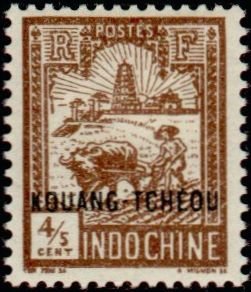Stamp: Farmer and Tower of Confucius (French Colonies 1927)
Farmer and Tower of Confucius (French Colonies 1927)
01 January (French Colonies ) within release Kouang-Tcheou goes into circulation Stamp Farmer and Tower of Confucius face value 4/5 French Indochinese cent
| Stamp Farmer and Tower of Confucius in catalogues | |
|---|---|
| Yvert et Tellier: | Yt:FR-KT76 |
Stamp is square format.
Also in the issue Kouang-Tcheou:
- Stamp - That-Luong face value 40;
- Stamp - Angkor face value 15;
- Stamp - Angkor face value 20;
- Stamp - Woodcarver face value 25;
- Stamp - Woodcarver face value 30;
- Stamp - That-Luong face value 50;
- Stamp - Foundation of Saigon face value 1;
- Stamp - Foundation of Saigon face value 2;
- Stamp - Along Bay face value 12;
- Stamp - Along Bay face value 10;
- Stamp - Along Bay face value 11;
- Stamp - Farmer and Tower of Confucius face value 1/10;
- Stamp - Farmer and Tower of Confucius face value 1/5;
- Stamp - Farmer and Tower of Confucius face value 2/5;
- Stamp - Farmer and Tower of Confucius face value 4/5;
- Stamp - Farmer and Tower of Confucius face value 1;
- Stamp - Farmer and Tower of Confucius face value 2;
- Stamp - Farmer and Tower of Confucius face value 3;
- Stamp - Farmer and Tower of Confucius face value 4;
- Stamp - Farmer and Tower of Confucius face value 5;
- Stamp - Along Bay face value 6;
- Stamp - Along Bay face value 7;
- Stamp - Along Bay face value 8;
- Stamp - Along Bay face value 9;
|
Data entry completed
46%
|
|
|---|---|
| Stamp Farmer and Tower of Confucius in digits | |
| Country: | French Colonies |
| Date: | 1927-01-01 |
| Perforation: | 13½ x 12 |
| Format: | Stamp |
| Face Value: | 4/5 French Indochinese cent |
Stamp Farmer and Tower of Confucius it reflects the thematic directions:
A tower is a tall structure, taller than it is wide, often by a significant factor. Towers are distinguished from masts by their lack of guy-wires and are therefore, along with tall buildings, self-supporting structures.
Agriculture is the cultivation and breeding of animals, plants and fungi for food, fiber, biofuel, medicinal plants and other products used to sustain and enhance human life.[1] Agriculture was the key development in the rise of sedentary human civilization, whereby farming of domesticated species created food surpluses that nurtured the development of civilization. The study of agriculture is known as agricultural science. The history of agriculture dates back thousands of years, and its development has been driven and defined by greatly different climates, cultures, and technologies. Industrial agriculture based on large-scale monoculture farming has become the dominant agricultural methodology.
Cattle (Bos taurus) are large, domesticated, bovid ungulates widely kept as livestock. They are prominent modern members of the subfamily Bovinae and the most widespread species of the genus Bos. Mature female cattle are called cows and mature male cattle are bulls. Young female cattle are called heifers, young male cattle are oxen or bullocks, and castrated male cattle are known as steers.



